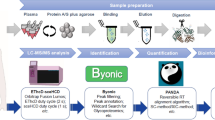Mass-spectrometric profiling of the serum in women at weeks 16-17 of gestation was carried out in order to detect proteomic predictors of preterm delivery. Changes in the production of 25 proteins (down-regulation for 13 proteins and up-regulation for 12 proteins) were detected in the sera of women whose pregnancies eventuated in premature deliveries. Among them, proteins with various regulatory functions were distinguished: antioxidant enzymes, chaperons, cytoskeleton proteins, cell adhesion molecules, and proteins involved in angiogenesis, proteolysis, transcription, inflammation processes, binding and transportation of various ligands. These results indicated the formation of proteomic imbalance as early as during trimester II, this eventually leading to premature delivery. The detected serum proteins were suggested as markers for early prediction of premature delivery.
Similar content being viewed by others
References
Minkevich NI, Lipkin VM, Kostanyan IA. PEDF – A noninhibitory serpin with neurotrophic activity. Acta Naturae. 2010;2(3):62-71.
Pakharukova NA, Pastushkova LKh, Moshkovskii SA, Larina IM. Variability of healthy human proteome. Biomed. Khim. 2012;58(5):514-529. Russian.
Pogorelova TN, Orlov VI, Gunko VO. New approaches to molecular diagnostics of prenatal pathology. Bull. Exp. Biol. Med. 2011;151(5):567-570.
Sidel’nikova VM, Sukhikh GT. Miscarriage. Guidance for practitioners. Moscow, 2010. Russian.
Anagnostopoulos AK, Tsangaris GT. Proteomics advancements in fetomaternal medicine. Clin. Biochem. 2013;46(6):487-496.
Buhimschi IA, Zhao G, Rosenberg VA, Abdel-Razeq S, Thung S, Buhimschi CS. Multidimensional proteomics analysis of amniotic fluid to provide insight into the mechanisms of idiopathic preterm birth. PLoS One. 2008;3(4):e2049.
Coe H, Michalak M. Calcium binding chaperones of the endoplasmic reticulum. Gen. Physiol. Biophys. 2009;28:F96-F103.
Kent AS, Sullivan MH, Sun MY, Zosmer A, Elder MG. Effects of interleukin-6 and tumor necrosis factor-alpha on prostaglandin production by cultured human fetal membranes. Prostaglandins. 1993;46(4):351-359.
Li GH, Arora PD, Chen Y, McCulloch CA, Liu P. Multifunctional roles of gelsolin in health and diseases. Med. Res. Rev. 2012;32(5):999-1025.
Loukovaara M, Koistinen R, Kalme T, Kurki T, Leinonen P, Seppälä M. Serum insulin-like growth factor-I and insulin-like growth factor binding protein-3 in premature rupture of membranes. Acta Obstet. Gynecol. Scand. 2002;81(10):905-908.
Preterm Birth: Causes, Consequences, and Prevention, Behrman RE, Stith Butler A, eds. Washington, 2007.
Ren R, Hashimoto T, Mizuno M, Takigawa H, Yoshida M, Azuma T, Kanazawa K. A lipid peroxidation product 9-oxononanoic acid induces phospholipase A2 activity and thromboxane A2 production in human blood. J. Clin. Biochem. Nutr. 2013;52(3):228-233.
Rho JH, Roehrl MH, Wang JY. Tissue proteomics reveals differential and compartment-specific expression of the homologs transgelin and transgelin-2 in lung adenocarcinoma and its stroma. J. Proteome Res. 2009;8(12):5610-5618.
Roepstorff P. Mass spectrometry based proteomics, background, status and future needs. Protein Cell. 2012;3(9):641-647.
Stricher F, Macri C, Ruff M, Muller S. HSPA8/HSC70 chaperone protein: structure, function, and chemical targeting. Autophagy. 2013;9(12):1937-1954.
Author information
Authors and Affiliations
Corresponding author
Additional information
Translated from Byulleten’ Eksperimental’noi Biologii i Meditsiny, Vol. 162, No. 6, pp. 789-792, June, 2016
Rights and permissions
About this article
Cite this article
Gunko, V.O., Pogorelova, T.N. & Linde, V.A. Proteomic Profiling of the Blood Serum for Prediction of Premature Delivery. Bull Exp Biol Med 161, 829–832 (2016). https://doi.org/10.1007/s10517-016-3522-z
Received:
Published:
Issue Date:
DOI: https://doi.org/10.1007/s10517-016-3522-z




